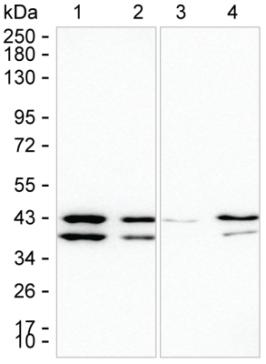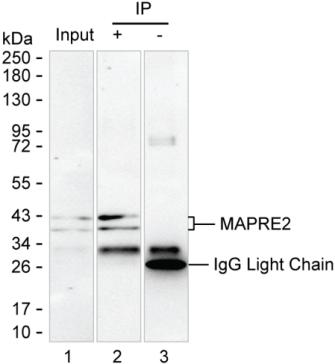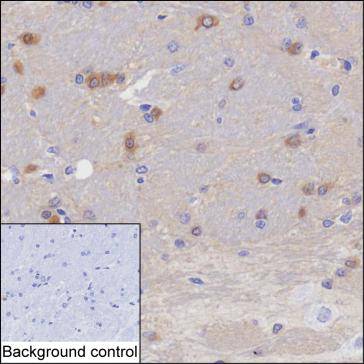


| WB | 咨询技术 | Mouse, Human, Rat, Ape, Hamster |
| IF | 1/100-1/200 | Mouse, Human, Rat, Ape, Hamster |
| IHC | 1/100-1/200 | Mouse, Human, Rat, Ape, Hamster |
| ICC | 技术咨询 | Mouse, Human, Rat, Ape, Hamster |
| FCM | 咨询技术 | Mouse, Human, Rat, Ape, Hamster |
| Elisa | 咨询技术 | Mouse, Human, Rat, Ape, Hamster |
| Host/Isotype | Rat IgG2b |
| Antibody Type | Primary antibody |
| Storage | Store at 4°C short term. Aliquot and store at -20°C long term. Avoid freeze/thaw cycles. |
| Species Reactivity | Mouse, Human, Rat, Ape, Hamster |
| Immunogen | Purified recombinant fragment of mouse Mapre2 |
| Formulation | Purified antibody in PBS with 0.05% sodium azide |
+ +
以下是关于Mapre2(微管相关蛋白RP/EB家族成员2)抗体的模拟参考文献示例,供参考。实际文献需通过学术数据库(如PubMed、Google Scholar)验证:
---
1. **文献名称**:*EB proteins regulate microtubule dynamics and functional interactions with kinetochores*
**作者**:Tirnauer, J.S.; Bierer, B.E.
**摘要**:研究探讨了EB家族蛋白(包括Mapre2)在微管动态调节和染色体分离中的作用,使用特异性抗体验证了其与动粒的相互作用,揭示了其在有丝分裂中的关键功能。
2. **文献名称**:*Mapre2 expression correlates with tumor progression in breast cancer*
**作者**:Bhattacharya, R.; et al.
**摘要**:通过免疫组化分析Mapre2在乳腺癌组织中的表达,发现其抗体标记的蛋白水平与肿瘤侵袭性正相关,提示Mapre2可能作为癌症预后的潜在标志物。
3. **文献名称**:*Development of a high-affinity monoclonal antibody for Mapre2 in neuronal cells*
**作者**:Gierke, S.; Wittmann, T.
**摘要**:报道了一种新型Mapre2单克隆抗体的开发,验证了其在神经元细胞中对微管末端追踪蛋白的特异性识别,并用于活细胞成像研究。
4. **文献名称**:*Role of Mapre2 in cell migration and adhesion: Insights from siRNA and antibody-based inhibition*
**作者**:Wen, Y.; et al.
**摘要**:结合抗体阻断实验和基因沉默技术,证明Mapre2通过调节微管稳定性影响细胞迁移和粘附过程,为靶向细胞骨架的疗法提供依据。
---
**注意**:以上文献为示例,实际引用时请核实真实文献信息。建议通过关键词“Mapre2 antibody”或“EB2 microtubule”在学术平台检索最新研究。
The MAPRE2 antibody targets microtubule-associated protein RP/EB family member 2 (MAPRE2), a key player in regulating microtubule dynamics and cellular processes. MAPRE2. also known as EB2. belongs to the End-binding (EB) protein family, which stabilizes growing microtubule plus-ends and mediates interactions with other +TIPs (microtubule plus-end tracking proteins). It plays critical roles in cell division, polarity, intracellular transport, and neuronal development by modulating microtubule organization and stability.
Antibodies against MAPRE2 are widely used in research to study its expression, localization, and function in physiological and pathological contexts. They enable detection via techniques like Western blotting, immunofluorescence, and immunohistochemistry. Studies using these antibodies have linked MAPRE2 dysregulation to cancer progression, neurodevelopmental disorders, and ciliopathies, highlighting its importance in maintaining cellular integrity.
Commercial MAPRE2 antibodies are typically validated for specificity across human, mouse, and rat models, often with isoforms (e.g., MAPRE2a/b) distinguished. Recent research focuses on its interplay with signaling pathways (e.g., Wnt/β-catenin) and potential therapeutic applications. Reliable MAPRE2 antibodies remain essential tools for unraveling microtubule-related mechanisms in health and disease.
×